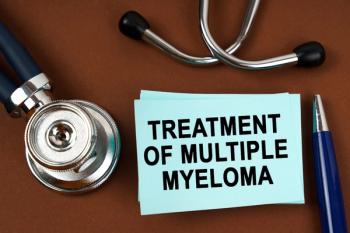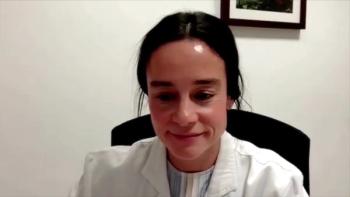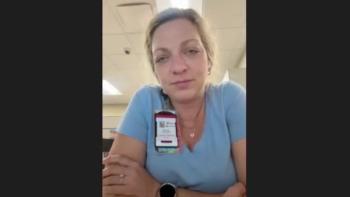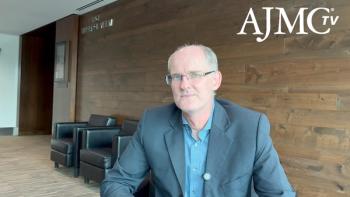
Frontline Use of Daratumumab-Based Regimens in Transplant-Ineligible MM
Insight on the survival benefit seen with frontline daratumumab-based regimens in patients with transplant-ineligible multiple myeloma.
Episodes in this series

Transcript:
Rafael Fonseca, MD: At the ASH [American Society of Hematology 2021] meeting we were able to present a simulation that we created to address the following questions. What do you have for frontline therapy of transplant ineligible patients? There are 2 main options. One is RVd [lenalidomide (Revlimid®), bortezomib (Velcade®), and dexamethasone]. The other one is the combination of daratumumab [Darzalex®], lenalidomide and dexamethasone—the MAIA regimen. Now, the RVd became the standard of care for frontline therapy of many myeloma patients because of the SWOG study as S0777 that studying the intention to treat populations showed an improvement of overall survival. However, as was published by Dr Durie [Brian G.M. Durie, MD], when you look at patients over the age of 65, we don’t see an improvement in overall survival. Then we have the MAIA trial, which has been presented and published that has shown a significant improvement in progression-free survival and overall survival. I use comparison between both approaches, which suggests that the duration of that response and the overall survival might be superior within MAIA regimen. This is again, just a naive comparison not a clinical trial. Also, the depth of the responses appears better with a MAIA combination. We asked ourselves the question, is it better to start with something like MAIA and then use other regimens for the rescue? Or is it better to start with something like RVd or even Rd [lenalidomide, dexamethasone] and then use daratumumab at your first relapse? Now, this is particularly important because we have a conundrum. We have the POLLUX study. The POLLUX study addresses daratumumab plus lenalidomide and dexamethasone for patients who are experiencing relapsing myeloma with excellent results with a PFS [progression-free survival] of approximately 50% of 4 years. Those results would suggest this is a great regimen that we have for that relapse. We couldn’t do a direct comparison because patients in POLLUX are about 10 years younger than what you would see with MAIA. Over 60% of them had a prior stem cell transplant. It was a younger, more fit population. How do we go about asking this question? We look at the data for dara [daratumumab]-Rd [lenalidomide, dexamethasone] and Rd for MAIA, and we use the Flatiron Health database to look at RVd frontline. Now, we did this as well with a solid data and the results are the same but that’s what we use RVd. Flatiron Health, that was number 1. Number 2 is we looked at the treatments that would be used for that first relapse. For patients that started with MAIA, we assumed a logical next step would be either carfilzomib [Kyprolis®] or pomalidomide [Pomalyst®]. For patients who started with VRd [bortezomib, lenalidomide, dexamethasone], or Rd, we assumed the next logical step would be a daratumumab combination. Again, we use the Flatiron data set and that was for the past 10 years, 2011 to 2021. In the middle—this is very important—we put attrition as a factor to do the simulation. The reason is the work from our group and that of others has shown that there’s a significant fraction of attrition by lines of therapy. We did this with real-world data set over 22,000 transplant-eligible patients and we show that up to 50% of them are loss per line of therapy. We put an upper and a lower boundary to do some sensitivity analysis. We put the current one for MAIA, but even if we focus on the conservative one that is 27.2%, which is very conservative, as opposed to that 50%, we found the following. We found that if you start with dara[daratumumab]-Rd and then you follow your treatment in relapse with carfilzomib and pomalidomide, you would have a median overall survival of approximately 9.1 years, which was 2 1/2 years longer than when you’ve started with RVd and then you go to dara [daratumumab]-base rescue. After 3 1/2 years that have started with Rd and then you go to a dara [daratumumab]-base rescue. We show this in our presentation of 5, 10, and 15 years. Again, this is a simulation. We all get it. This would be best addressed and there might be one day where there’s a prospective randomized phase 3 clinical trial. But since these are both regimens that are encompassed in the NCCN [National Comprehensive Cancer Network] guidelines and the mSMART [Mayo Stratification of Myeloma and Risk-Adapted Therapy] guidelines, we thought this would be an important analysis. Furthermore, the combination of daratumumab, lenalidomide and dexamethasone is free of peripheral neuropathy which remains a problem with bortezomib. Based on all of this, I conclude that I recommend that the combination of daratumumab, lenalidomide, and dexamethasone becomes the preferred regimen for patients in this category.
Transcript edited for clarity.
Newsletter
Stay ahead of policy, cost, and value—subscribe to AJMC for expert insights at the intersection of clinical care and health economics.

















































